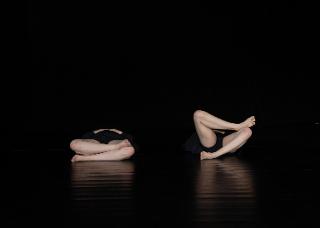| dc.description.abstract | The project deals with the relationship between anatomical structure and aesthetic values in dance. The project's title refers to the work of William Forsythe, using the rotation of the hip as motivation for improvised movement material. The extreme external rotation of the hip joint is an essential movement in ballet technique. However, is this tradition relevant to contemporary dance techniques? The project investigates if the hip joint's pure function can be a valuable choreographic concept.
THE TEAM
Dr. Irina Kalabiska, sports physiology researcher; Zsuzsa Rózsavölgyi, choreographer, movement researcher; Laura Tóth, dancer, choreographer; Boglárka Simon-Hatala, physiotherapist.
THE CORE QUESTIONS
What are the advantages and disadvantages of extreme external or extreme internal rotation? Which are the noticeable movements that make the differences visible? Is it possible to perform a unison with such an anatomical difference? Can the concept indicate an interesting movement material and exciting performance?
METHOD
During the artistic research phase, we used the results of the scientific research phase to ensure that the rotation capacity of the hip joint between two dancers can be significant. We choose two dancers with opposite capabilities. Then, we went through many hip joint movements to see where the different capabilities were the most impressive. We created improvised and fixed movement material, one with more external hip rotation and one with more internal hip rotation. We saw significant differences in how the movements looked on different bodies. Then, we created a movement material that tried to dance the material in unison, but we failed because of the anatomical advantages and disadvantages. After the movement research phase, we created a lecture performance about the traditional and contemporary points of view on the hip joint's ability for artistic expression.
RESULTS
First, we conducted a scientific inquiry into the anatomy of the hip joint. We wanted to find scientific evidence to prove that the geometry of the hip joint determines the range of movement in the hip joint. We measured the rotation of the hip joint, took x-ray pictures of the hip joint, and measured the geometrical angles of the femur. The measurements of external and internal hip rotations showed no significant correlation between the length of the neck of the femur and the angle of the neck of the femur. There is no relation between the geometry of the femur and the ability to rotate the hip joint. It is good news for dance teachers because the shape of the bone does not affect the movement. However, our data shows a correlation between starting ballet training early, before puberty, and external rotation. The ligaments are more supple and adaptable during childhood. The second part of the project was the artistic exploration of the functionality of hip rotation in movement and how it affects artistic expression. We needed two dancers with opposite hip rotational abilities - one with extreme external rotation capacity and one with extreme internal rotation capacity. The material we found during the movement research phase has a much more significant potential than we thought. The anatomical differences are apparent and easily detected. It is impossible to dance in true unison with two different rotation abilities. The movement material can show students, teachers, and choreographers that external rotation is overrated and that there is a great need to explore internal rotation. | en_US |


